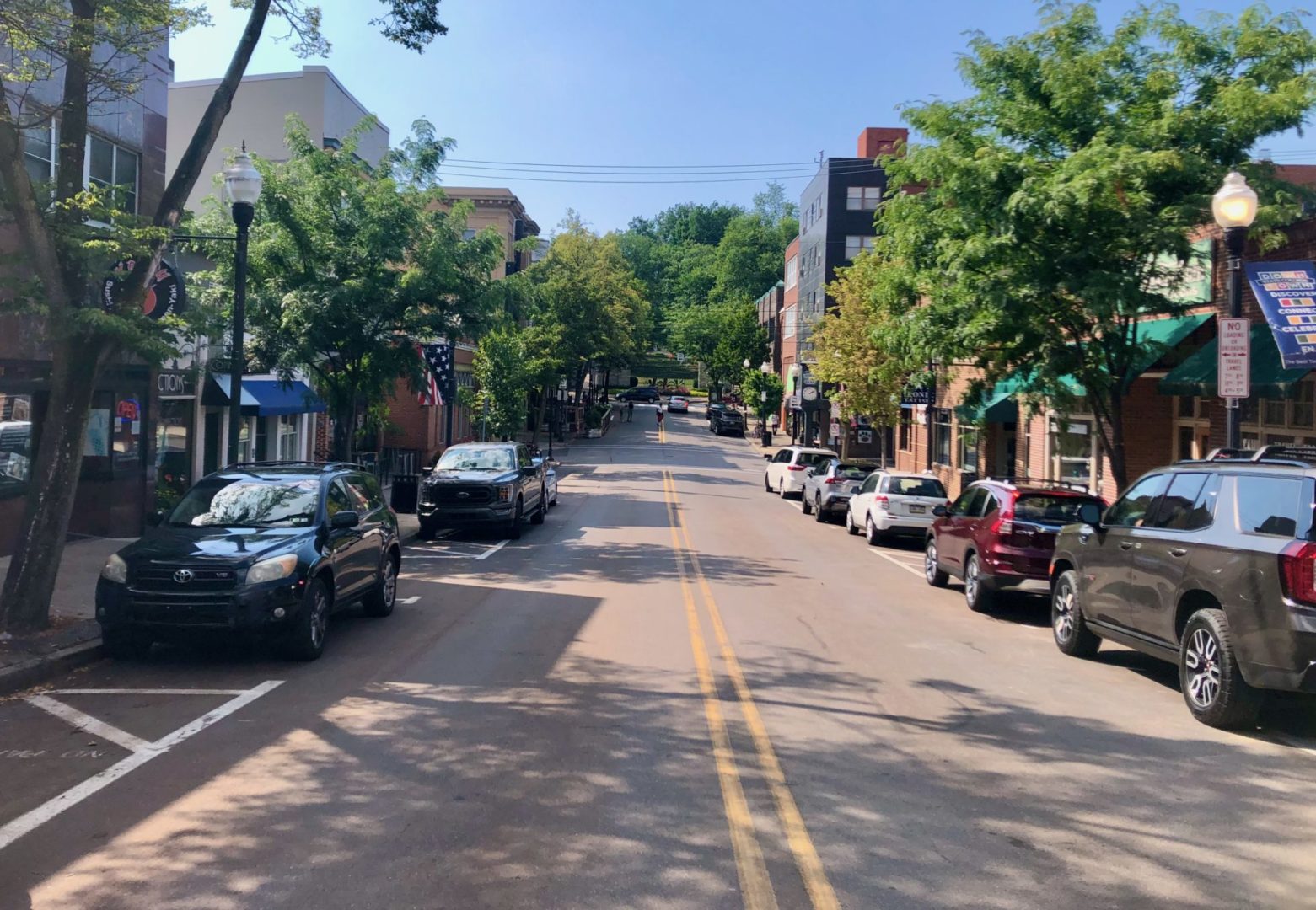
South Allen Street in State College on July 20, 2022. Photo by Geoff Rushton | StateCollege.com

South Allen Street in State College on July 20, 2022. Photo by Geoff Rushton | StateCollege.com
State College has begun work on a comprehensive plan for the future of the transportation network in the borough.
The Next Generation Connectivity and Mobility Plan will assess existing conditions and develop goals and projects for everything from bicycling to walking to public transit to vehicle traffic, State College Sustainability Officer Jasmine Fields said during Monday night’s borough council meeting.
“We have a desire to really build out infrastructure that’s connected and provides access to different modes of transportation for everybody, people of all ages and abilities,” Fields said. “We’re really looking to develop that comprehensive plan that really looks at everything in our transportation network.”
As part of the 10-month project, a public engagement plan will offer community members and organizations the opportunity to provide their input. Residents can now take a survey on existing mobility resources and issues and participate in a comment map with site-specific input that will inform analysis for the plan. The survey and map are available on the project engagement website.
State College is working on the plan with transportation engineering and planning consultant Kittelson and Associates of Philadelphia, which was awarded the $207,253 contract in July, as well as engineering consultant JMT for data collection and analysis. Borough staff, along with Centre Regional Planning Association, Penn State Transportation Services, CATA and PennDOT officials, are providing project oversight and meeting on a monthly basis.
Several topics covering the breadth of transportation will be included in the plan, including traffic calming, curb management and parking strategy. It will evaluate expanding on micro-mobility — like the Spin e-bike share launched last year — and accommodating “emerging technologies that come as a part of that,” Fields said.
Analyzing public transit in partnership with CATA, Fields said the plan will look to ensure “that our network is accessible to everybody and really is efficient for people that are trying to get around.”
An implementation strategy will guide development of capital projects that support the goals of the plan.
Council member Gopal Balachandran said he hopes the plan will proactively model a bike-friendly community and will encourage greater bicycle infrastructure and capacity “so that people can bike safely from one end of the borough to the other.”
Fields replied that bike infrastructure will be a component of the plan.
“… We’re really looking at getting people out of cars and getting them to use different modes from walking to taking the bus to riding their bikes,” Fields said. “In the title, it’s ‘connectivity and mobility,’ so really looking at projects that can help us to make our infrastructure network more connected and that’s through bike lane improvements … as well as just connecting facilities. Having bike share stations, or sort of mobility hubs, looking at connecting everything from transit to walking and making things more bikeable and walkable for everybody.”
The borough’s comprehensive bicycle and pedestrian plan published in 2008 marked the starting point for the connectivity and mobility plan, Fields said.
“The conversations around the update of this plan really provided the foundation for the development of our new mobility plan,” she said. “Instead of just solely focusing on the bicycle and pedestrian issues, the next generation plan is really going to look at our entire transportation network, everything from public transit to safety to traffic calming.”
Since the 2008 plan, the borough adopted in 2017 a Complete Streets policy “to design, construct, and maintain a public right of way that safely and adequately accommodates all users and all modes of transportation.”
“So the Next Generation plan is going to provide us with ways we can implement that Complete Streets policy, which really guides us in developing and planning our roadways and our right of way in a way that’s safe and efficient for all different modes of transportation,” Fields said. “That policy is really the foundation of this new plan that we’re developing.”
The plan will “build off existing community plans, ordinances and policies,” Fields said. The consultants were required to have a strong understanding of the Centre Region Bike Plan, the Penn State Bike Plan and the Downtown Improvement Plan, among others “that really show the priorities for where we want things to be.”
Fields added that staff and the consultants are working with CATA, which is developing its own long-range planning, to collaborate and make sure the plans are in sync.
State College’s plan also will look to align with Pennsylvania’s Active Transportation Plan developed in 2019 to provide a framework for improving walking and bicycling conditions in communities throughout the commonwealth.
The timeline for the plan is split into three phases. This fall and winter will involve analyzing existing conditions, data collection and identifying areas of concern. In addition to the survey and comment map, the planning team will hold an open house for public officials and will have meetings and interviews with stakeholders, including representatives of the Centre County Metropolitan Planning Organization, Centre Regional Planning Association, State College Area School District, CATA, Penn State, the Downtown State College Improvement District and civic groups such as Centre Region Bicycle Advisory Committee.
Winter and spring of 2023 will include developing recommendations and prioritization of projects, as well as a public open house. In the late spring, a draft plan will be presented to State College Borough Council, Planning Commission and Transportation, with a final plan due in May.
“This is an exciting time,” Mayor Ezra Nanes said. “This is a really great plan. I hope the public will participate in the opportunities when those arise. It’s going to be a great chance to shape our future in this regard.”
Receive all the latest news and events right to your inbox.

80% of consumers turn to directories with reviews to find a local business.